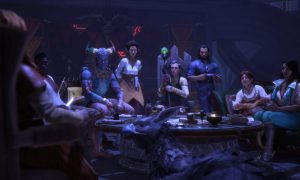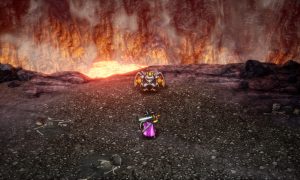 It seems like a lot of people have been bemoaning the death of the horror genre lately. Modern gaming, they claim, has abandoned true horror games in favor of shooters which merely attempt to scare. Indeed, this attitude is so widespread that one of the marketing taglines for Shinji Mikami’s upcoming return to the genre is #BringBackHorror
It seems like a lot of people have been bemoaning the death of the horror genre lately. Modern gaming, they claim, has abandoned true horror games in favor of shooters which merely attempt to scare. Indeed, this attitude is so widespread that one of the marketing taglines for Shinji Mikami’s upcoming return to the genre is #BringBackHorror
It’s easy to look at the massive AAA releases out on the market now and to say that horror is gone–and I’ll admit, it’s hard to look at a game like DeadSpace 3 or Resident Evil 6 and not feel that some essential quality is missing. In these modern, big budget games, the player is far too powerful. Desperation and vulnerability are not the feelings that come to mind while mowing down space-zombies by the hundreds. So, what happened to old-school survival horror? What happened to big budget horror games? Put simply, 2005 happened.
[singlepic id=13758 w=320 h=240 float=left]Prior to 2005, we had a very specific genre we played when we wanted to feel our spines tingle: survival horror. Old survival-horror games were, in many ways, very similar to modern action-horror games. Both old and modern games share bleak settings, nihilist storylines, and widespread darkness but there was something about the old-school survival horror games that set them apart from their descendants. There were two characteristics that defined the genre:
-
Scarce ammunition
-
Sluggish, awkward controls
Most of the best survival horror games of the 90s and early 00s–games like Resident Evil 2, Fatal Frame, ClockTower, and Silent Hill–mixed these traits into a witch’s brew of fear and desperation. By limiting ammunition and giving the player awkard control schemes, the developer could create a sense of vulnerability. But then 2005 came along, bringing with it three games which would shatter gamers’ assumptions about what makes a horror game.
Resident Evil 4 came first, launching on the venerable Gamecube before being ported to the PS2 later that year. While still limiting access to ammunition, RE4 revolutionized the horror genre with its slick over-the-shoulder camera, smooth gunplay, and incredible AI. By shrugging off the classic, awkward controls RE4 made the horror genres much more accessible, netting both rave critical reviews and excellent sales. Looking back on the past decade or so, it’s nearly impossible to overstate the impact Resident Evil 4 has had on blockbuster horror franchises.[singlepic id=13756 w=320 h=240 float=right]
The next blow came from Monolith Production’s FEAR (I won’t dignify that terrible acronym F.E.A.R.). While RE4 made attempts to preserve its survival-horror roots, FEAR ignored the genre outright. Drawing inspiration from Hard Boiled and The Ring in equal measures, FEAR was unique in completely uncoupling the horror themes from the action. Horror sequence followed action sequence followed horror sequence, and ne’er the two shall meet. FEAR wasn’t a horror game, it was a polished military shooter that had a horror gloss, and while it certainly wasn’t the first shooter to introduce horror elements—obligatory System Shock 2 reference here—few shooters had ever relied upon them so heavily before. FEAR proved that as long as a game had atmosphere and could make the player jump, it didn’t have to obey the standard survival horror rules regarding ammunition and controls to be successful.
Between those two games, we can see the foundations for modern big-budget action-horror games. RE4 and FEAR bridged the gap between old-school survival-horror and the immensely popular action and shooter genre. After these two games hit the market, you’d be hard pressed to find any really successful old-school survival horror game. On the other hand, games like Resident Evil 5 and Dead Space continued the trends established in 2005 and sold like crazy, further cementing the emerging AAA action-horror genre. However, a third game that came out in 2005 set the stage for an emerging horror underground.
[singlepic id=13753 w=320 h=240 float=left]Released in October 2005, Call of Cthulhu: Dark Corners of the Earth was essentially ignored for years. What makes this game special is the extraordinary patience and self-control shown by the developers. Call of Cthulhu spends nearly all of the first two hours establishing a palpable sense of dread, culminating in an incredible chase that remains one of the scariest scenes in the history of gaming. The player is completely helpless for much of the game, relying on stealth, wits, and a bit of luck to survive.
Despite its quality scares, Call of Cthulhu had some major issues. First conceived in 1999, it spent nearly 4 years in development hell before being pushed–unfinished–out the door by Bethesda. When it finally launched, it was an ugly, buggy mess that never caught on with the commercial markets. Yet though it was ignored by the larger gaming community, Call of Cthulhu gained traction with fans of horror games, shining a light on an alternate path for the genre. While blockbuster franchises like FEAR and Dead Space drifted further from their horror roots, mid-level and indie developers took to horror by emulating Call of Cthulhu’s focus on atmosphere and pacing.
It would take a few years for Call of Cthulhu’s spawn to manifest themselves, but when the next wave of “true” horror games came of age, it did so by tossing aside many of the old survival horror tropes. Frictional Games’ 2007 debut Penumbra: Overture, defined the Swedish studio’s brand of horror with its narrative driven, first person misadventures and strong emphasis on physics puzzles instead of object-based fetch quests that plagued the old guard. Over the next few years, Frictional would refine their approach before releasing their magnum opus in Amnesia: The Dark Descent.[singlepic id=13755 w=320 h=240 float=right]
Ukraine-based Action Forms is another mid-level studio that seems to have drawn heavily upon Call of Cthulhu, though their 2009 title Cryostasis swapped out a dreary American towns for Arctic ice floes. Cryostasis has a strong emphasis on psychological horror. Unfortunately most people have never even heard of Cryostasis because its technological flaws drew the ire of critics when it was released.
Indie PC developers have also been doing a lot for the horror genre, focusing on pacing and innovation instead of hyper-real production values. Jasper Byrne’s Lone Survivor is a harrowing experience that would have fit right in with old-school survival horror giants like Silent Hill. Andrew Shouldice’s freeware effort Hide is one of the most exhilarating horror games out there, mixing the first person survival horror mechanics of Amnesia with evocative pixel-art aesthetics. And then, of course there’s Slender, the freeware game that spooked the entire gaming community last year.
In the years since RE4 et al were released, the horror gaming world has essentially diverged in two separate directions. On the one hand, you have your blockbuster franchises like Alan Wake or Dead Space, which paste horror themes and settings onto action-adventure game mechanics. Here’s the thing: there isn’t anything wrong with that. Horror themes are fun, they give developers a chance to create some truly horrifying creatures, and when they’re done moderately well can even get a few scares out of you. Lots of games have smeared gory horror themes over shooter or action game mechanics, going all the way back to Doom.
[singlepic id=13754 w=320 h=240 float=left]But on the other hand, we’ve also seen the rise of a community of developers creating some of the scariest games yet made, working with fractions of the amount of money the blockbuster titles get So, stop trying to “bring horror back,” because the truth is that horror never left—it just mutated.
Addie grew up near Detroit. After studying Cell Biology at the University of Michigan and spending a year looking into microscopes, Addie decided to volunteer--playing video games. hobbies run from gaming to music (voice, bass, guitar) to rugby. Addie is a strong supporter of indie and low-cost gaming, an area she thinks is underserved by the media.

See below for our list of partners and affiliates:

























